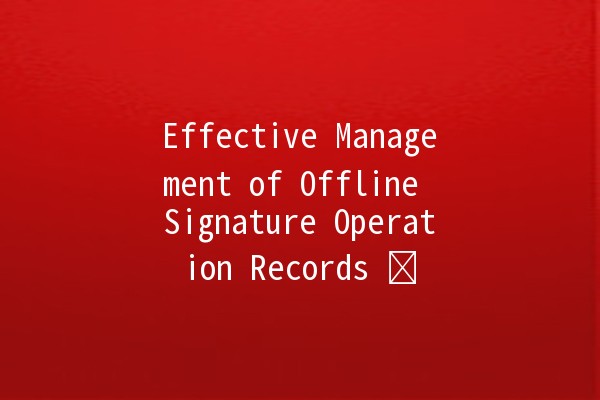
In today’s digital world, the need for secure and verifiable documentation remains prominent, despite the advancements in online signatures and electronic documentation. Offline signature management is essential for many sectors, including finance, legal, and healthcare, where physical signatures are still required. This article delves into the effective management of offline signature operation records, offering practical tips and strategies to enhance productivity while ensuring the integrity and security of these important documents.
Understanding Offline Signature Management
Offline signature management refers to the processes and systems in place to handle and store signed documents that are generated and maintained without the use of the internet. This typically involves physical signatures on paper documents, which are later scanned or digitally entered into management systems for recordkeeping.

Importance of Offline Signature Management
Boosting Productivity in Offline Signature Operations
Managing offline signatures requires efficiency to avoid delays in processes that hinge on these documents. Below are key productivityenhancing techniques supported by practical applications.
A centralized management system streamlines the process of storing, retrieving, and managing offline signatures.
Application Example: A company can utilize an electronic document management software that allows employees to scan and upload signed documents after collection, making them easily accessible for future reference or audits.
Creating specific guidelines for collecting and managing offline signatures minimizes confusion and enhances compliance.
Application Example: Design a standard operating procedure (SOP) that outlines who is responsible for collecting signatures, when to do so, and how to handle the documents thereafter. This should include using preprinted forms with clear instructions for signatories.
Incorporate tools that allow tracking the status of documents requiring signatures, thus providing a visual representation of progress.
Application Example: Implement a project management tool featuring todo lists and progress tracking, where team members can check the status of documents in realtime, increasing accountability and reducing bottlenecks.
Education is vital in ensuring that all employees understand the importance of proper signature management and are aware of best practices.
Application Example: Conduct regular training sessions that cover the significance of offline signature management, how to use the document management system effectively, and the legal implications of improper handling of signed documents.
Conducting frequent audits of offline signature records encourages consistent adherence to protocols and helps identify areas for improvement.
Application Example: Set a quarterly schedule for reviewing the compliance of signature management processes, where employees can assess the effectiveness of the systems in place and implement changes based on their findings.
Common Concerns in Offline Signature Management
While managing offline signatures, certain issues may arise that can impact productivity, security, or compliance. Here are some common questions and answers to address these concerns.
Physical documents containing signatures should be stored in a secure environment, such as locked filing cabinets or safes. Additionally, limit access to authorized personnel only to enhance security further.
To ensure the authenticity of a signature, implement a verification process that includes establishing a unique identifying feature like a pen type or signature style that is recorded at the time of signing.
Improperly managed signatures can lead to legal disputes, compliance issues, and loss of credibility. This can result in financial losses and damage to the brand’s reputation.
Technology can streamline offline signature management by providing electronic document management systems, enabling realtime monitoring of signature requests, and automating reminders for pending signatures.
If a signature is disputed, investigate promptly by reviewing the related documents, reaching out to the signatory for clarification, and considering legal counsel if necessary to understand your rights and obligations.
Yes, transitioning to digital signatures can simplify the signing process and improve security. However, ensure that all stakeholders are informed and that regulatory compliance is maintained throughout the transition.
Best Practices for Offline Signature Management
Enhance Communication: Regularly communicate with team members about the importance of managing offline signatures effectively.
Maintain Backup Records: Always keep backups of scanned copies of signed documents to prevent loss due to damage or disaster.
Incorporate Redundancy: Designate multiple individuals responsible for managing signature requests to ensure continuity and accountability.
Use Secure Transportation: When transporting documents that require signatures, use secure methods (e.g., couriers) to avoid loss or tampering.
Create a Supportive Culture: Encourage a culture of responsibility and attention to detail around managing signatures to reinforce the importance of compliance.
By integrating these techniques and addressing common concerns, organizations can significantly improve their offline signature management processes. This not only enhances productivity and security but also fosters a culture of accountability and efficiency that is critical in today’s competitive environment.
, effective offline signature operation record management is crucial for maintaining compliance, security, and efficiency within an organization. By implementing structured management processes, educating staff, and utilizing technology, businesses can navigate the complexities of maintaining physical signature records while reaping the benefits of improved productivity and traceability.

